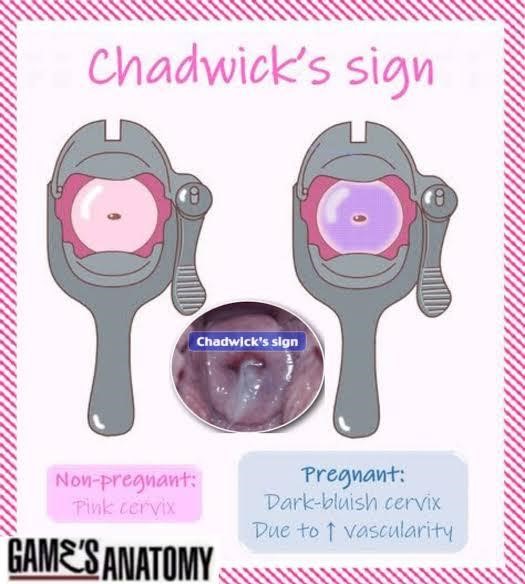On the first prenatal visit, examination of the woman's internal genitalia reveals a bluish coloration of the cervix and vaginal mucosa. The nurse documents this finding as:
Chadwick's sign
Goodell's sign
Hegar's sign
Homan's sign
The Correct Answer is A
Choice A Reason: This is correct because Chadwick's sign is a bluish or purplish discoloration of the cervix, vagina, and vulva caused by increased blood flow to the pelvic area during pregnancy. It is one of the earliest signs of pregnancy and can be observed as early as six to eight weeks of gestation.
Choice B Reason: This is incorrect because Goodell's sign is a softening of the cervix due to increased vascularity and edema during pregnancy. It is another early sign of pregnancy and can be detected by palpation around six to eight weeks of gestation.
Choice C Reason: This is incorrect because Hegar's sign is a softening of the lower uterine segment or isthmus during pregnancy. It is also an early sign of pregnancy and can be felt by bimanual examination around six to twelve weeks of gestation.
Choice D Reason: This is incorrect because Homan's sign is a pain in the calf or popliteal region when the foot is dorsiflexed. It is a sign of deep vein thrombosis, which is a potential complication of pregnancy, but not a normal finding.

Nursing Test Bank
Naxlex Comprehensive Predictor Exams
Related Questions
Correct Answer is ["B","C","D","E"]
Explanation
Choice A Reason: This is incorrect because ultrasound visualization of the fetus is a positive sign of pregnancy, not a probable sign. A positive sign of pregnancy is a direct and definitive evidence of the presence of a fetus, such as fetal movement felt by the examiner or fetal heart sounds heard by a Doppler device.
Choice B Reason: This is correct because softening of the cervix, also known as Goodell's sign, is a probable sign of pregnancy. A probable sign of pregnancy is a strong indication of pregnancy based on physical changes in the reproductive organs, such as enlargement of the uterus or changes in the shape and consistency of the cervix.
Choice C Reason: This is correct because a positive pregnancy test, which detects human chorionic gonadotropin (hCG) in urine or blood, is a probable sign of pregnancy. However, it is not a conclusive sign, as hCG can also be produced by other conditions such as ectopic pregnancy, molar pregnancy, or trophoblastic tumors.
Choice D Reason: This is correct because absence of menstruation, also known as amenorrhea, is a probable sign of pregnancy. It occurs when ovulation and menstruation cease due to hormonal changes during pregnancy. However, it is not a definitive sign, as amenorrhea can also be caused by other factors such as stress, illness, or hormonal imbalances.
Choice E Reason: This is correct because ballottement, which is a rebounding of the fetus against the examiner's fingers during a pelvic examination, is a probable sign of pregnancy. It can be felt around 16 to 20 weeks of gestation.
Choice F Reason: This is incorrect because auscultation of a fetal heart beat, which can be heard by a fetoscope around 18 to 20 weeks of gestation or by a Doppler device around 10 to 12 weeks of gestation, is a positive sign of pregnancy, not a probable sign.
Correct Answer is B
Explanation
Choice A Reason: This is incorrect because difficulty in arousing is a sign of magnesium toxicity, which is a serious complication of magnesium sulfate therapy. Magnesium toxicity can cause central nervous system depression, muscle weakness, and cardiac arrest. The nurse should monitor the client's level of consciousness and stop the infusion if the client becomes lethargic or unresponsive.
Choice B Reason: This is correct because deep tendon reflexes 2+ indicate a normal and expected response to magnesium sulfate therapy. Magnesium sulfate is a muscle relaxant that can reduce the risk of seizures in gestational hypertension. The nurse should assess the client's deep tendon reflexes regularly and maintain them at 2+ or slightly diminished.
Choice C Reason: This is incorrect because urinary output of 30 mL per hour is below the normal range of 40 to 80 mL per hour and may indicate renal impairment or dehydration. Magnesium sulfate can cause renal toxicity or fluid retention, which can affect the urinary output. The nurse should monitor the client's urinary output and fluid balance and report any abnormalities to the doctor.
Choice D Reason: This is incorrect because respiratory rate of 10 breaths/minute is below the normal range of 12 to 20 breaths/minute and may indicate respiratory depression. Magnesium sulfate can cause respiratory depression or failure, which can be life-threatening. The nurse should monitor the client's respiratory rate and oxygen saturation and administer oxygen or antidote if needed.
Whether you are a student looking to ace your exams or a practicing nurse seeking to enhance your expertise , our nursing education contents will empower you with the confidence and competence to make a difference in the lives of patients and become a respected leader in the healthcare field.
Visit Naxlex, invest in your future and unlock endless possibilities with our unparalleled nursing education contents today
Report Wrong Answer on the Current Question
Do you disagree with the answer? If yes, what is your expected answer? Explain.
Kindly be descriptive with the issue you are facing.
